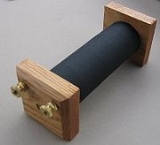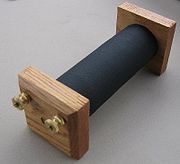
Low tension coil
Encyclopedia
A low tension coil is an electrical device used to create a spark
across the points of an ignitor
on early 1900s gasoline
engines, generally flywheel engines, hit and miss engine
s, and other engines of that era. In modern electronic terms, a low tension coil is simply a large inductor
, an electrical device that stores energy for brief periods. The term "low tension" was the terminology of the day used to differentiate it from the term "high tension", and generally meant "low voltage" (tension) as opposed to "high voltage" (tension). High tension coils produce high voltages, generally meant to produce a spark across a spark plug.
 A low tension coil consists of an iron core that has wire wrapped around it. The size of the iron core, the number of turns of wire, and the size of the wire determine the electrical properties of the coil. Terminals are provided to connect the coil into the ignition circuit. The wood ends are provided for mechanical stability, to provide for the terminal placement and to hold the wire on the coil over time. A cloth or tape covering is provided to protect the windings.
A low tension coil consists of an iron core that has wire wrapped around it. The size of the iron core, the number of turns of wire, and the size of the wire determine the electrical properties of the coil. Terminals are provided to connect the coil into the ignition circuit. The wood ends are provided for mechanical stability, to provide for the terminal placement and to hold the wire on the coil over time. A cloth or tape covering is provided to protect the windings.
Electric spark
An electric spark is a type of electrostatic discharge that occurs when an electric field creates an ionized electrically conductive channel in air producing a brief emission of light and sound. A spark is formed when the electric field strength exceeds the dielectric field strength of air...
across the points of an ignitor
Ignitor
Ignitor is a heavy metal band based in Austin, Texas, USA.- History :Ignitor was formed in 2003 by Erika Tandy , Stuart Laurence aka Batlord , Pat Doyle , Beverly Barrington , and Brendon Bigelow...
on early 1900s gasoline
Gasoline
Gasoline , or petrol , is a toxic, translucent, petroleum-derived liquid that is primarily used as a fuel in internal combustion engines. It consists mostly of organic compounds obtained by the fractional distillation of petroleum, enhanced with a variety of additives. Some gasolines also contain...
engines, generally flywheel engines, hit and miss engine
Hit and miss engine
A hit-and-miss engine is a type of four-stroke internal combustion engine that was conceived in the late 19th century and was produced by various companies from the 1890s through approximately the 1930s. The name comes from the method of speed control that is implemented on these engines...
s, and other engines of that era. In modern electronic terms, a low tension coil is simply a large inductor
Inductor
An inductor is a passive two-terminal electrical component used to store energy in a magnetic field. An inductor's ability to store magnetic energy is measured by its inductance, in units of henries...
, an electrical device that stores energy for brief periods. The term "low tension" was the terminology of the day used to differentiate it from the term "high tension", and generally meant "low voltage" (tension) as opposed to "high voltage" (tension). High tension coils produce high voltages, generally meant to produce a spark across a spark plug.
Construction

Use
A low tension coil for engine ignition is used in conjunction with a battery and an ignitor. The ignitor is no more than a set of contacts that reside inside the combustion chamber of the engine. A series circuit is made between the three components: battery connects to coil, second terminal on the coil connects to the ignitor, second terminal on the ignitor (usually connected electrically and mechanically to the engine itself) connects to the second terminal of the battery.Theory of Operation
An inductor attempts to maintain a constant current flow through it. If the current in the circuit in which the inductor is connected goes down for some reason, the voltage developed across the inductor will go up in an attempt to try to maintain the constant current. When used with an ignitor ignition system in an engine, there is current flow when the ignitor contacts are closed. When the ignitor contacts are opened by the mechanical parts of the engine, current flow is interrupted. Because the low tension coil wants to maintain that current flow, the voltage across the coil rapidly goes up (usually to several hundred volts). When the voltage rises high enough, the voltage will jump the still very small gap of the ignitor contacts and create a spark which ignites the fuel mixture in the engine. Since there is a finite amount of energy stored in the coil, as soon as the spark jumps the gap the voltage across the coil collapses. As soon as the engine rotates and the ignitor contacts again close, current starts to flow through the coil and it again stores energy for the next cycle. A good description and moving gif of a low tension coil in operation can be found on Harrys Old Engines Ignition PageSee also
- ElectromagnetismElectromagnetismElectromagnetism is one of the four fundamental interactions in nature. The other three are the strong interaction, the weak interaction and gravitation...
- Faraday's law of inductionFaraday's law of inductionFaraday's law of induction dates from the 1830s, and is a basic law of electromagnetism relating to the operating principles of transformers, inductors, and many types of electrical motors and generators...
- Ignition coilIgnition coilAn ignition coil is an induction coil in an automobile's ignition system which transforms the battery's 12 volts to the thousands of volts needed to create an electric spark in the spark plugs to ignite the fuel...
- InductorInductorAn inductor is a passive two-terminal electrical component used to store energy in a magnetic field. An inductor's ability to store magnetic energy is measured by its inductance, in units of henries...
- Induction coilInduction coilAn induction coil or "spark coil" is a type of disruptive discharge coil. It is a type of electrical transformer used to produce high-voltage pulses from a low-voltage direct current supply...
- Magnetic fieldMagnetic fieldA magnetic field is a mathematical description of the magnetic influence of electric currents and magnetic materials. The magnetic field at any given point is specified by both a direction and a magnitude ; as such it is a vector field.Technically, a magnetic field is a pseudo vector;...

